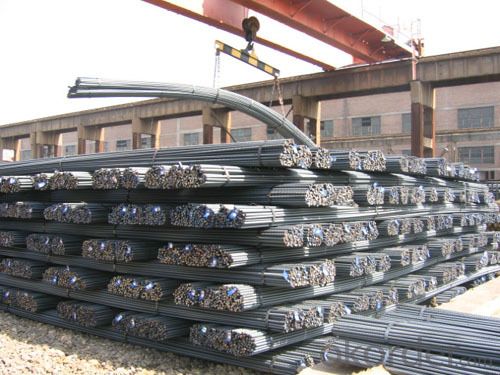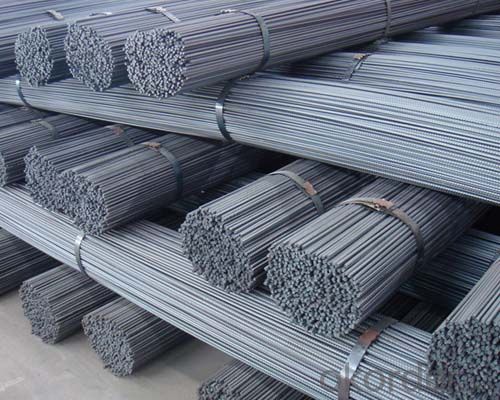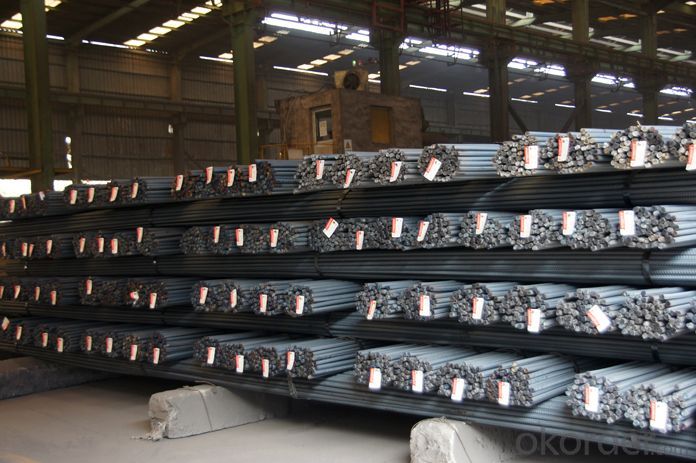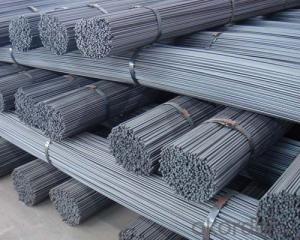HRB400 deformed bars with competitive price
- Loading Port:
- Tianjin
- Payment Terms:
- TT OR LC
- Min Order Qty:
- 25 m.t.
- Supply Capability:
- 100000 m.t./month
OKorder Service Pledge
OKorder Financial Service
You Might Also Like
Product Description:
Specifications of HRB400 Deformed Steel Bar:
Standard | GB | HRB400 | |
Diameter | 10mm-32mm | ||
Length | 6M, 12M | ||
Place of origin | Hebei, China mainland | ||
Advantages | exact size, regular package, chemical and mechanical properties are stable. | ||
Type | Hot rolled deformed steel bar | ||
Chemical Composition: (Please kindly find our chemistry of our material based on HRB400 as below for your information)
Grade | Technical data of the original chemical composition (%) | ||||||
C | Mn | Si | S | P | V | ||
HRB400 | ≤0.25 | ≤1.60 | ≤0.80 | ≤0.045 | ≤0.045 | 0.04-0.12 | |
Physical capability | |||||||
Yield Strength (N/cm²) | Tensile Strength (N/cm²) | Elongation (%) | |||||
≥400 | ≥570 | ≥14 | |||||
Theoretical weight and section area of each diameter as below for your information:
Diameter(mm) | Section area (mm²) | Mass(kg/m) | Weight of 12m bar(kg) |
18 | 254.5 | 2.00 | 24 |
20 | 314.2 | 2.47 | 29.64 |
22 | 380.1 | 2.98 | 35.76 |
Usage and Applications of HRB400 Deformed Steel Bar:
Deformed bar is widely used in buildings, bridges, roads and other engineering construction. Big to highways, railways, bridges, culverts, tunnels, public facilities such as flood control, dam, small to housing construction, beam, column, wall and the foundation of the plate, deformed bar is an integral structure material. With the development of world economy and the vigorous development of infrastructure construction, real estate, the demand for deformed bar will be larger and larger..
Packaging & Delivery of HRB400 Deformed Steel Bar:
Packaging Detail: products are packed in bundle and then shipped by container or bulk vessel, deformed bar is usually naked strapping delivery, when storing, please pay attention to moisture proof. The performance of rust will produce adverse effect.
Each bundle weight: 2-3MT, or as required
Payment term: TT or L/C
Delivery Detail: within 45 days after received advanced payment or LC.
Label: to be specified by customer, generally, each bundle has 1-2 labels
Trade terms: FOB, CFR, CIF



*If you would like to get our price, please inform us the size, standard/material and quantity. Thank you very much for your attention.
- Q:Can steel rebars be used in wastewater storage tanks?
- Indeed, wastewater storage tanks can utilize steel rebars. These rebars are frequently employed as reinforcement in concrete structures, including wastewater storage tanks. By imparting tensile strength to the concrete, the rebars enhance its resistance to cracking and bolster the overall structural integrity of the tank. Moreover, steel rebars possess corrosion-resistant properties, a crucial attribute given the inevitable exposure to corrosive elements in wastewater storage tanks. Consequently, the utilization of steel rebars in these tanks is a prevalent and efficacious practice within the construction industry.
- Q:Are steel rebars susceptible to rust?
- Steel rebars can be easily affected by rust. Typically composed of carbon steel, rebars contain iron. When they come into contact with moisture and oxygen, the iron reacts and forms rust, also known as iron oxide. The presence of salt or other corrosive materials speeds up this process. The weakening of rebars due to rust formation can eventually cause structural harm if not addressed. Hence, it is vital to safeguard steel rebars by applying a suitable coating or utilizing alternative methods of corrosion prevention. This measure guarantees the durability and structural soundness of reinforced concrete structures.
- Q:Can steel rebars be used in underground construction or tunnels?
- Yes, steel rebars can be used in underground construction or tunnels. Steel rebars provide crucial reinforcement to concrete structures, enhancing their strength and durability. In underground construction or tunnel projects, where structural integrity is of utmost importance due to the surrounding soil and potential pressure, steel rebars are commonly used to reinforce concrete walls, floors, and ceilings, ensuring the safety and stability of the underground structures.
- Q:How do steel rebars distribute loads in concrete structures?
- Steel rebars distribute loads in concrete structures by providing reinforcement and increasing the tensile strength of the concrete. The rebars are typically placed in the concrete in a grid-like pattern, creating a network of support throughout the structure. When the concrete is subjected to external loads, such as the weight of the building or the force of an earthquake, the rebars help distribute the load more evenly across the structure. This prevents the concrete from cracking or failing under the stress. Rebars work by transferring the tensile forces to the surrounding concrete. While concrete is strong in compression, it is relatively weak in tension. The rebars act as a reinforcement, resisting the tensile forces and preventing the concrete from cracking. When a load is applied to the structure, the rebars bear a portion of the load and distribute it to adjacent rebars and the surrounding concrete, effectively increasing the overall strength and stability of the structure. The distribution of loads in concrete structures is also influenced by the spacing and diameter of the rebars. Properly spacing the rebars ensures that the load is evenly distributed, minimizing the risk of localized stress concentration. The diameter of the rebars also plays a role in load distribution, as larger diameter rebars can withstand higher loads and provide more reinforcement. In addition to load distribution, steel rebars also help control the propagation of cracks within the concrete. When cracks do occur, the rebars help prevent them from spreading by transferring the stress around the cracked area and maintaining the structural integrity of the concrete. Overall, steel rebars play a critical role in distributing loads in concrete structures by providing reinforcement, increasing tensile strength, and controlling crack propagation. Their strategic placement and proper sizing ensure that the loads are evenly distributed, enhancing the durability and longevity of the structure.
- Q:Can steel rebars be used for both residential and commercial construction?
- Yes, steel rebars can be used for both residential and commercial construction. Steel rebars are commonly used to reinforce concrete structures, such as foundations, walls, and beams, in a wide range of construction projects, including both residential and commercial buildings. The use of steel rebars provides strength and durability to the concrete, ensuring the integrity of the structure in both types of construction.
- Q:Can steel rebars be used in residential swimming pool construction?
- Yes, steel rebars can be used in residential swimming pool construction. Steel rebars provide structural reinforcement to the pool walls and floor, ensuring stability and durability.
- Q:How do steel rebars contribute to the sustainability of a building?
- Steel rebars contribute to the sustainability of a building in several ways. Firstly, they provide structural strength and durability, allowing the building to withstand natural disasters and remain functional for a longer period. This reduces the need for frequent repairs or reconstruction, ultimately reducing resource consumption and waste generation. Secondly, steel rebars are recyclable, meaning they can be reused in future construction projects, reducing the demand for raw materials and minimizing the environmental impact of steel production. Additionally, the use of steel rebars in reinforced concrete structures allows for the use of thinner and lighter concrete sections, resulting in reduced material usage and lower carbon emissions during construction and transportation. Overall, steel rebars enhance the longevity, efficiency, and environmental performance of buildings, making them more sustainable.
- Q:How do steel rebars affect the crack width in reinforced concrete?
- Steel rebars play a crucial role in controlling and minimizing the crack width in reinforced concrete structures. The primary function of steel rebars is to provide tensile strength to the concrete, as concrete alone is weak in tension. When a load is applied to the reinforced concrete, the steel rebars resist the tensile forces, preventing cracks from widening. The presence of steel rebars helps distribute the stress and strain more evenly throughout the concrete. As a result, the cracks that may occur due to external loads or shrinkage are confined and their width is limited. The rebars act as reinforcement, inhibiting the propagation of cracks and reducing their width. This is especially important in structural elements such as beams and columns, where crack control is critical for maintaining the integrity and durability of the structure. The diameter, spacing, and arrangement of the rebars also influence the crack width in reinforced concrete. Properly designed and placed rebars provide optimal crack control. As the diameter and spacing of the rebars decrease, the crack width decreases as well. Additionally, the arrangement of rebars in a specific pattern, such as using a mesh or a grid, can further enhance crack control by providing additional resistance to crack propagation. Moreover, the bond between steel rebars and concrete is essential in crack width control. Adequate bond strength ensures that the rebars effectively transfer stress to the concrete, limiting crack width. Insufficient bond can lead to slip between the steel rebars and the concrete, allowing cracks to widen. In summary, steel rebars significantly affect crack width in reinforced concrete by providing tensile strength, distributing stress and strain, confining cracks, and enhancing the bond between the steel and concrete. Proper design, placement, and arrangement of rebars are crucial for effective crack control, improving the overall performance and longevity of reinforced concrete structures.
- Q:What is the difference between rebar bolts and steel bars?
- This question can only be answered: "material should not be compared to components.". Insist on saying the difference, one is the material, and the other is the component.You may ask the difference between soil nail and anchor bar, but the topic is not. I shall be glad to answer another question!
- Q:How do steel rebars affect the overall durability of marine structures?
- Steel rebars greatly enhance the overall durability of marine structures. These reinforced bars provide additional strength and resilience, making the structures more resistant to corrosion, fatigue, and the constant exposure to harsh marine environments. By reinforcing the concrete, steel rebars increase the structural integrity, preventing cracks and enhancing load-bearing capacity, ensuring that marine structures can withstand the forces of waves, tides, and weather conditions, thereby prolonging their lifespan.
1. Manufacturer Overview |
|
|---|---|
| Location | |
| Year Established | |
| Annual Output Value | |
| Main Markets | |
| Company Certifications | |
2. Manufacturer Certificates |
|
|---|---|
| a) Certification Name | |
| Range | |
| Reference | |
| Validity Period | |
3. Manufacturer Capability |
|
|---|---|
| a)Trade Capacity | |
| Nearest Port | |
| Export Percentage | |
| No.of Employees in Trade Department | |
| Language Spoken: | |
| b)Factory Information | |
| Factory Size: | |
| No. of Production Lines | |
| Contract Manufacturing | |
| Product Price Range | |
Send your message to us
HRB400 deformed bars with competitive price
- Loading Port:
- Tianjin
- Payment Terms:
- TT OR LC
- Min Order Qty:
- 25 m.t.
- Supply Capability:
- 100000 m.t./month
OKorder Service Pledge
OKorder Financial Service
Similar products
New products
Hot products
Related keywords





























